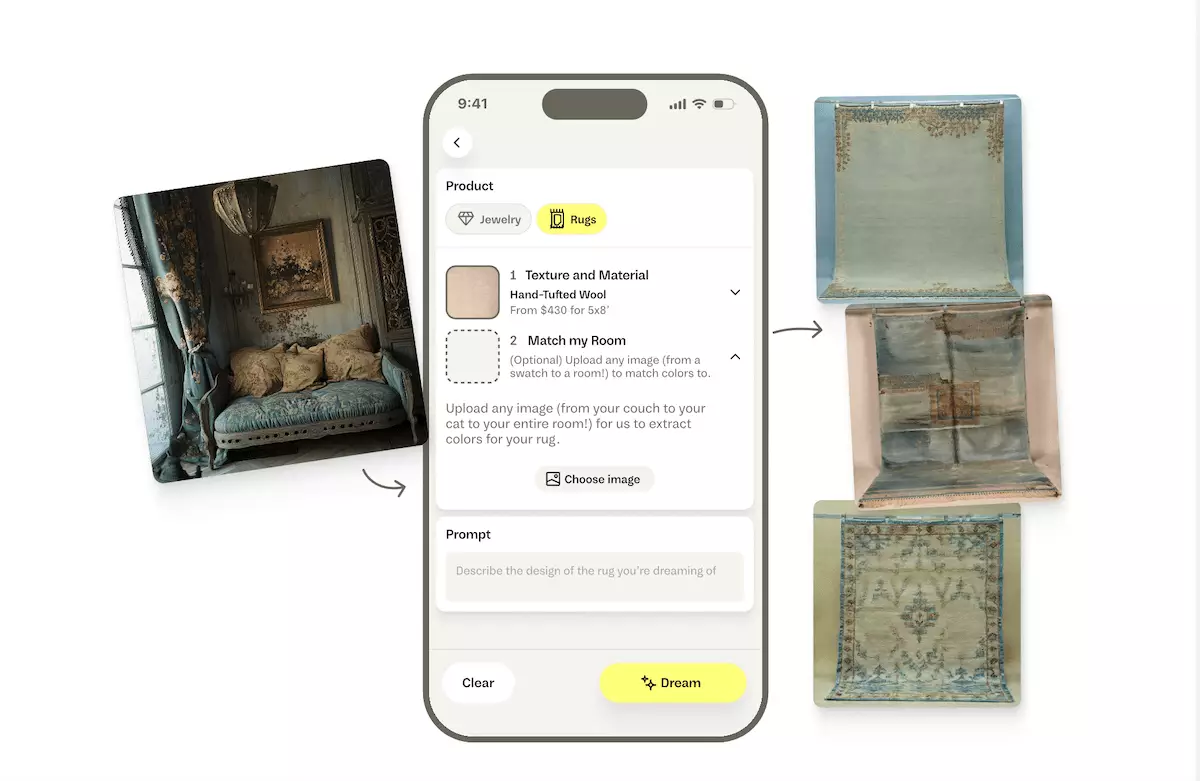In a world where customization reigns supreme, Arcade has taken a creative leap by expanding its generative AI marketplace from jewelry design to home goods, with the launch of their first product: rugs. This audacious transition signifies not only an adaptation to consumer demands but also highlights a powerful trend in the home decor industry. The move is particularly impressive when considering the intricate balance they must maintain between artistic expression and practical application.
While Arcade has successfully carved a niche in the jewelry sector, their foray into home goods reflects an understanding of the larger market dynamics. Home decor enthusiasts increasingly seek personalized items that resonate with individual styles. Arcade’s introduction of the “Match My Room” feature serves as a practical tool for users looking to synthesize new rugs with their existing interior aesthetics. By allowing users to upload a photo of their room, the AI-powered system aims to suggest color palettes that align with the user’s decor, fostering a seamless blend of existing and new elements within a space.
Pioneering Technology: Merging Design with AI
The technology underlying Arcade’s new rug design feature is equally noteworthy. Using advanced tools like Midjourney and Stable Diffusion, users can not only specify rug material but also provide descriptive text prompts that shape the final design. This connection between human creativity and artificial intelligence showcases a new frontier for design, where the lines between artist and machine blur.
However, while the initial offerings feature 3×9 hand-tufted wool rugs starting at around $400, the escalating prices for premium materials such as cashmere and alpaca might present a stumbling block for potential consumers. Though Arcade positions itself as a more affordable alternative to luxury rug retailers, it remains to be seen whether their price points will genuinely attract budget-conscious buyers who typically shy away from high-cost items.
Enhancing User Experience: The Role of Dream Boards
In addition to the rug initiative, Arcade has unveiled its “Dream Boards,” an engaging platform feature mirroring Pinterest’s concept of thematic curation. Users can curate collections of designs, allowing for an organic overflow of inspiration and ideas. This functionality not only boosts user engagement but also fosters a community-driven approach to design, where individuals can share visions and perhaps make purchases from one another’s curated selections.
Yet, there is a caveat: while these boards promote sharing and creativity, Arcade has not disclosed critical metrics about design popularity or user purchasing behavior. This lack of transparency raises questions about the effectiveness of the Dream Boards in driving sales and retaining customer interest. By providing more insight into how users interact with these features, Arcade could gain valuable feedback to refine and enhance its platform.
Empowering Creators: The Seller and Affiliate Programs
One of the most intriguing aspects of Arcade’s platform is the robust seller program that allows users to earn a commission on the sales of their products. The recent increase from a 2.5% to a 5% commission is a strategic move to motivate creators while attracting a broader array of sellers. Moreover, the introduction of an affiliate program designed for content creators offers higher commission rates, which can potentially unlock significant income sources for those engaged in digital content creation.
Arcade’s targeted outreach to influential media personalities and content creators emphasizes their commitment to building a strong ecosystem around their products. This strategy not only benefits sellers but could also enhance Arcade’s brand presence in an increasingly competitive landscape, as influencers often have dedicated followings that can catalyze consumer interest.
Investment and Growth: The Road Ahead
The recent Series A funding of $25 million, which raises the total to $42 million, indicates investor confidence in Arcade’s vision and capabilities. Spearheaded by industry veterans like Mariam Naficy, Arcade is on a growth trajectory. The allocation of these funds toward hiring talent and developing new product categories such as ceramics and pillows signals plans for diversification and expansion. The prospect of integrating more everyday items into their marketplace poses exciting opportunities for industry disruption.
However, while the hype surrounding new categories is generating buzz, the efficacy of Arcade’s business model remains to be validated over time. The current ecosystem is competitive, driven by both traditional retailers and emerging players alike. Investors and consumers alike will be watching closely to see how Arcade navigates its ambitious plans, and whether they can maintain the momentum necessary to sustain growth in a rapidly evolving market.

